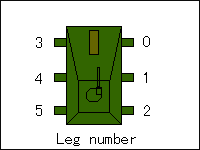

Oval orbit
1.Generate the orbit that the foot follows.
2.Divide the orbit with proper unit and get the points.
3.Calculate the angles of each joint for the points. (Inverse kinematics)
4.Calculate the output data for the servomotors at the joint angles.
(This set of data consists of control waves.)


Oval orbit

The length of part of the orbit " F->A->B" is around 70mm and the unit is about 6mm. The maximum force to downward that each leg can generate is depending on the coordinate where the foots can reach. When PC controls the robot, the total weight of the robot is about 1900g. And when the robot is in "tether-less field-testing mode", the total weight of the robot is about 2600g. You can see in movies on the top page that the robot is walking faster in "PC control mode" than "tether-less field-testing mode".

------Strait forward------------Strait diagonally------
Turning:
The orbit that foots follow is calculated as following
steps. The result of the calculation is an oval on a cylinder.
1.Decide the "center of turning"At the figure below, the green lines are the part of the orbit that the feet are touching on the ground. And the red line is the locus that the center of the robot follows.
(It is outside of the triangle which is consists from footprint.)
2.Rotate the triangle around the "center of turning"
(Locus that each of the apices follows consists the part of the orbit that the feet are touching on the ground.)
3.Calculate the part of the orbit that the feet are not touching on the ground.

Turn
1.Decide the "center of turning"At the figure below, the green lines are the part of the orbit that the feet are touching on the ground. The "center of the robot" and the "center of turning" is the same point at this example. So the robot dose not change the place but just change the direction at the place. It is like a kind of tank that is moving its each tracks towards opposite direction.
(It is inside of the triangle which is consists from footprint.)
2.Rotate the triangle around the "center of turning"
(Locus that each of the apices follows consists the part of the orbit that the feet are touching on the ground.)
3.Calculate the part of the orbit that the feet are not touching on the ground.

Turn at the place
Changing a course:
The robot can change its course with changing the control wave.
Each of the control waves that before and after must have the
same speed at the center of the robot to change direction smoothly.